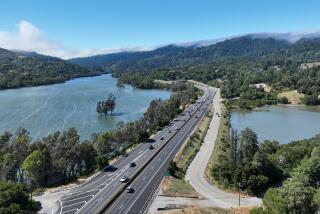Fix for Truck Traffic Stalls
- Share via
Moorpark leaders have run into another setback in their long struggle to keep big rigs from clogging traffic through town.
The city hired a Pasadena engineering firm last summer to analyze truck traffic on California 118 to identify safety issues that might convince state officials to prohibit all trucks except those making local deliveries.
The results are about as encouraging as a flat tire.
Although a nuisance, commercial trucks on California 118 from Moorpark to Saticoy are not especially dangerous and pose no particular environmental problems, according to the study by Parsons Corp. presented last week to the City Council.
“It’s very frustrating,” said Mayor Pro Tem Keith Millhouse, who is also chairman of the Ventura County Transportation Commission. “This is going to require us to come up with some creative ways to ease the impact” of truck congestion.
Veteran council member Clint Harper called it “an uphill battle” to seek restrictions in light of the Parsons report.
Public Works Director Kenneth C. Gilbert suggested Moorpark instead urge the California Highway Patrol to increase enforcement at a temporary inspection location it operates west of town and move ahead with plans for a permanent weigh station along the highway.
“We’re going to have to look at other mitigation measures that have a better chance of succeeding,” Harper said. “I think a permanent inspection and weigh station makes a lot of sense. I always have.”
The 2-inch-thick Parsons document said trucks account for 8% to 10% of the up to 57,800 vehicles that roll down Moorpark’s main thoroughfare, also known as New Los Angeles Avenue, on an average day. A third of those trucks serve local farms or the city’s wastewater treatment facility.
From 1993 to 2002, there were 345 accidents on that stretch of California 118, part of which is on the National Highway System. About half of the 60 accidents involving trucks were blamed on the big rigs or their drivers, similar to the situation on other rural roads. There was only one fatal accident in which a trucker was considered at fault.
The study said some truckers use California 118 in an attempt to avoid inspections at the Ventura Freeway’s truck scales on the Conejo Grade. But since 9/11, the CHP has boosted staffing at the Moorpark mini-station, which is open daily from 6 a.m. until dark, according to CHP Officer Karlene Reynolds. The Conejo Grade facility has operated 24 hours a day since the terrorist attacks.
Reynolds said expanded enforcement near Moorpark seems to be paying off, because fewer trucks were taken out of service for safety violations in February as compared with February 2001.
“They’re noticing that we’re out there and it’s certainly making an impression on them in terms of maintenance of the vehicles,” she said.
Parsons’ environmental assessment of nonlocal trucks determined that the vehicles don’t significantly pollute the air, exceed noise standards or threaten underground water supplies. And a review of the roadway’s hills, curves and dips between California 23 and Vineyard Avenue shows that the highway conforms to conventional rural highway design standards.
That conclusion surprises Harper, who said he has on several occasions witnessed 18-wheelers flip over trying to navigate the S-curve west of town near Mesa School.
“I thought the engineering defects were more substantial than those reported by the engineering consultant,” he said.
It is Parsons’ noise-level findings that Councilwoman Janice Parvin disputes. Parvin, who once worked in an office on New Los Angeles Avenue, said that when trucks were on the street, a visitor couldn’t hear what the lobby receptionist was saying.
But Parvin said the issue has been studied long enough and it’s time for permanent solutions, including developing alternate routes -- such as a long-discussed bypass that would route east-west traffic in a large arc through the north end of town and deposit it directly onto the Ronald Reagan Freeway.
Millhouse, who with Mayor Pat Hunter serves as the council’s traffic subcommittee, wants to hold a “truck summit” to question freight line operators, farmers and haulers serving gravel mines north of town about their willingness to adjust their operations to keep trucks off city streets during peak morning and afternoon rush hours.
Other alternatives to be discussed, he said, include truck-only traffic lanes, creating an underground bypass or truck tunnel beneath New Los Angeles Avenue and pushing to have more port cargo head east on the railroad.
However, a county Transportation Commission report in December 2000 concluded that the Port of Hueneme accounted for less than 2% of the trucks passing through Moorpark.
More to Read
Sign up for Essential California
The most important California stories and recommendations in your inbox every morning.
You may occasionally receive promotional content from the Los Angeles Times.













